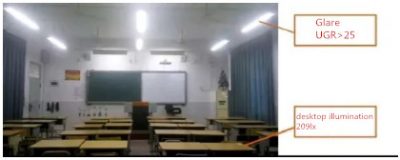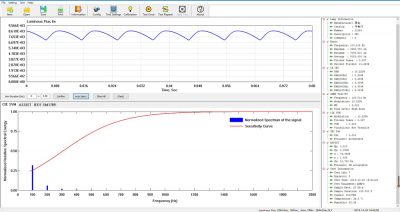The myopia rate of primary and secondary school students remains high. More and more people are advocating to pay attention to the improvement of students’ eyesight and the healthy lighting of classrooms, especially parents of students and classrooms. The education industry has also issued relevant standards, such as classroom lighting and lighting hygiene standards in primary and secondary schools. Myopia prevention and control work plan for primary school students, classroom lighting and lighting hygiene standards in primary and secondary schools, etc. So what are the standards for educational lighting in campus classrooms?
LED blackboard light and classroom light, the two lamps meet six major indicators: no blue light hazard, no glare, scientific light distribution, no light stroboscopic hazard, moderate color temperature, and high color rendering index.
No blue light hazard
I believe everyone is familiar with the word “blue light”. The most commonly used word in optical shops is “anti-blue light”. If ordinary LED lamps are not treated with anti-blue light, it is harmful. Professional educational lighting LED lamps have been professionally treated and have reached the exemption level, without blue light hazard.
No Glare
Since LED is a solid lighting source, the human eye will feel dazzling which is actually a kind of glare effect. The so-called glare means that the strong light emitted by the light source enters our eyes through various ways, causing a dizzy, unclear and dazzling feeling to our eyes. The light emitted by the eye protection lamp should be uniform and soft, the brightness should be appropriate, the light area should be moderate, and the illumination should be uniform.
The “Standards for Lighting and Lighting Hygiene in Classrooms of Primary and Secondary Schools” pointed out that the uniform glare value (URG) of classrooms should not be greater than 19.
Based on the research on the cooperation project with the Educational Equipment Research and Development Center of the Ministry of Education, whether it is a remote rural school or a key school in a first- and second-tier city, most of the fluorescent lamps and ordinary LED lamps used in classroom lighting have serious glare problems, which are easy to cause. Students are short-sighted, distracting students’ attention and affecting learning efficiency. The data shows that the glare value of traditional T8 bracket fluorescent lamps and ordinary LED lamps without glare treatment is greater than 20, causing glare. Studying in this environment for a long time will cause students to feel dizzy.

Glare in Classroom

Glare in Classroom
LISUN design and manufacture GTS-LS glare measurement system adopts a high-precision imaging luminance meter. The high-precision measurement and analysis of the unified glare index UGR is realized through a precision electronically controlled pan-tilt and special measurement and control software. The measurement stability is good, the speed is fast, and the system is small in size and light in weight.
Scientific light distribution
“Classroom Lighting and Lighting Hygiene Standards for Primary and Secondary Schools” points out that all classrooms should be equipped with artificial lighting, and the maintained average illuminance value on the classroom desktop should not be less than 300lx, and its illuminance uniformity should not be less than 0.7; classroom blackboards Local lighting should be set up, and its average illuminance value should not be lower than 500lx, and the illuminance uniformity should not be lower than 0.8.
At present, the lighting fixtures used in most classrooms are still fluorescent lamps. The average illuminance of the desk and the blackboard is less than 200lx, and the blackboard is not specially illuminated. During self-study at night, the lack of light is very obvious, which is easy to cause students to study too close to the desktop. When looking at the text on the blackboard, my eyes will squinting unconsciously, especially the students in the back row. This can lead to eye fatigue and myopia.
In addition to avoiding too dark and too bright, the educational lighting of campus classrooms also needs to control the uniformity of light. Some schools did not plan the installation of lamps, and installed them directly and uniformly. The installation method was inflexible, the debugging was difficult, and the fans, beams, and air outlets were not avoided, and the light was not fully utilized.
No light stroboscopic hazard
Stroboscopic refers to the periodic change of intensity, brightness and darkness of light over time. If the eye protection lamp has stroboscopic, the pupil will sometimes dilate and sometimes shrink. Using such a lamp for a long time will cause soreness and fatigue of the human eye. May affect vision. Usually we use lights. Most of them use 50Hz alternating current, there is stroboscopic, and the human eye can only observe stroboscopic below 30Hz per second. Therefore, strictly speaking, the eye protection lamp is not actually “not flashing” like some advertisements say, but the flashing frequency is relatively high, our naked eyes can not distinguish it, it is an imperceptible stroboscopic, but It is regarded as no stroboscopic, but this does not mean that the screen will not flicker. Classroom lighting should use high-quality LED light sources with stable lighting that are invisible to the naked eye.
The impact of stroboscopic on eyesight is the most obvious, it is very easy to distract students’ attention and reduce the efficiency of learning.
When the traditional T8 fluorescent lamp is started and the voltage is unstable, the stroboscopic phenomenon is particularly serious, and when the current is stable, the light stroboscopic (fluctuation depth) is also greater than 40%, and the light stroboscopic of ordinary LED lamps is also greater than 20%. Time to study in this environment is also easy to cause visual fatigue. The light stroboscopic of professional LED educational lighting is less than or equal to 3.2%, which is far lower than the former two.
LISUN design and manufacture LSRF-3 Lamp Start, Run-up Time and Flicker Test System needs to work with LISUN’sLSP-500VARC AC Power Source (With Trigger Function) or LSP-500VARC-Pst (IEC-Pst AC Power Source)to test the Start and Run-up time of lamps which is according toclause 11.4 Start Time Test Method & clause 11.5 Run-Up Time Test Methodin the US Standards ofEnergy Star V2.1,andSASO2902Table 13:

Flicker test report

Flicker test report
Moderate color temperature
“Classroom Lighting and Lighting Hygiene Standards for Primary and Secondary Schools” states that classrooms should use light sources with a color temperature of 3300K-5500K. At present, the color temperature of most professional LED educational lighting fixtures is 5000K, which belongs to warm white light. However, there are still many schools using traditional T8 fluorescent lamps and ordinary LED lamps, and their color temperature is greater than 6500K, which belongs to cool white light.
High color temperature fluorescent tubes (6500k) are generally used in most classrooms. Because the light is too white, it is easy to cause students to be excited and easy to cause fatigue.
High color rendering index
Color rendering is the color display under the illumination of the light source, the displayed color is closer to the color displayed under natural light or standard light, the color rendering is good. On the contrary, it is poor. The color rendering index is used to express the quality of color rendering. According to the current recommendation of the International Lighting Committee (adopted by my country’s national standards), the maximum color rendering index is 100. So under the illumination of the light source, the (various) colors displayed are exactly the same as the colors displayed under the illumination of natural light or standard light, and the larger the difference, the smaller the value.
The “Classroom Lighting and Lighting Hygiene Standards for Primary and Secondary Schools” points out that the color rendering index of classroom lighting sources should not be less than 80. The data shows that the color rendering index of traditional T8 bracket fluorescent lamps and LED ordinary lamps without glare treatment is about 70, which is not enough. If can not reach to 80, and the color rendering index of less than 80 will distort the picture you see.

Lightsource test report
Lisun Instruments Limited was found by LISUN GROUP in 2003. LISUN quality system has been strictly certified by ISO9001:2015. As a CIE Membership, LISUN products are designed based on CIE, IEC and other international or national standards. All products passed CE certificate and authenticated by the third party lab.
Our main products are Goniophotometer, Integrating Sphere, Spectroradiometer, Surge Generator, ESD Simulator, EMI Receiver, EMC Test Equipment, Electrical Safety Tester, Environmental Chamber, Temperature Chamber, Climate Chamber, Thermal Chamber, Salt Spray Test, Dust Test Chamber, Waterproof Test, RoHS Test (EDXRF), Glow Wire Test and Needle Flame Test.
Please feel free to contact us if you need any support.
Tech Dep: Service@Lisungroup.com, Cell/WhatsApp:+8615317907381
Sales Dep: Sales@Lisungroup.com, Cell/WhatsApp:+8618917996096
Your email address will not be published. Required fields are marked *